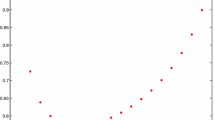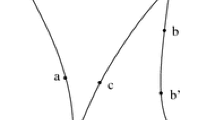Abstract
We investigate the behaviour of simplicial depth under the perturbation (1−ε)F+ε δ z , where F is a p-dimensional probability distribution and δ z is the point-mass distribution concentrated at the point z. The influence function of simplicial depth at the point x, up to a scalar multiplier, turns out to be the difference between the conditional depth, given that one of the vertices of the random simplex is fixed at the position z, and the unconditional depth. The scalar multiplier is p+1, which suggests that simplicial depth can be more sensitive to perturbations as the dimensionality grows higher. The geometrical properties of the influence function give new insight into the observed behaviour of simplicial depth and its relation with halfspace depth. The behaviour of the perturbed simplicial median is also investigated.
Similar content being viewed by others
References
Arcones, M.A., Chen, Z., Giné, E.: Estimators related to u-processes with applications to multivariate medians: asymptotic normality. Ann. Stat. 22, 1460–1477 (1994)
Chen, Z.: Bounds for the breakdown point of the simplicial median. J. Multivar. Anal. 55, 1–13 (1995)
Donoho, D., Gasko, M.: Breakdown properties of location estimates based on halfspace depth and projected outlyingness. Ann. Stat. 20, 1803–1827 (1992)
Hampel, F.: The influence curve and its role in robust estimation. J. Am. Stat. Assoc. 69, 383–393 (1974)
Hampel, F.R., Ronchetti, E.M., Rousseeuw, P.J., Stahel, W.A.: Robust Statistics: the Approach Based on Influence Functions. Wiley, New York (1986)
Liu, R.Y.: On a notion of data depth based on random simplices. Ann. Stat. 18, 405–414 (1990)
Liu, R.Y., Singh, K.: Ordering directional data: concepts of data depth on circles and spheres. Ann. Stat. 20, 1468–1484 (1992)
Liu, R.Y., Parelius, J.M., Singh, K.: Multivariate analysis by data depth: descriptive statistics, graphics and inference. Ann. Stat. 27, 783–858 (1999)
Molchanov, I.: Theory of Random Sets. Springer, London (2005)
Romanazzi, M.: Influence function of halfspace depth. J. Multivar. Anal. 77, 138–161 (2001)
Romanazzi, M.: Corrigendum to: Influence function of halfspace depth. J. Multivar. Anal. 81, 187–188 (2002)
Serfling, R.J.: Approximation Theorems of Mathematical Statistics. Wiley, New York (1980)
Serfling, R.J.: Generalized quantile processes based on multivariate depth functions with applications in nonparametric multivariate analysis. J. Multivar. Anal. 83, 232–247 (2002)
Tukey, J.W.: Mathematics and picturing of data. In Proceedings of International Congress of Mathematics, vol. 2, p. 523 (1975)
Zuo, Y., Serfling, R.J.: General notions of statistical depth function. Ann. Stat. 28, 461–482 (2000)
Author information
Authors and Affiliations
Corresponding author
Rights and permissions
About this article
Cite this article
Romanazzi, M. A note on simplicial depth function. Adv Stat Anal 92, 235–253 (2008). https://doi.org/10.1007/s10182-008-0073-2
Received:
Accepted:
Published:
Issue Date:
DOI: https://doi.org/10.1007/s10182-008-0073-2




